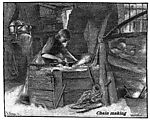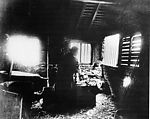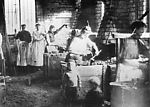“…wizened infants hanging to their mothers’ breasts, as these ply the hammer, or sprawling in the mire on the floor, amidst the showers of fiery sparks”. Robert Sherard - 1896
When reading the description of life in a chain-shop, particularly a domestic chain-shop, we invariably learn that children were present. The sight of children working in chain-shops would offend modern-day sensibilities, but in the 19th and early 20th centuries, it was commonplace. Indeed, the women had little choice but to keep their children with them if they were below school attendance age, as to employ a child carer would have been financially prohibitive
Childhood legally ended at fourteen, so from that age they were expected to be as productive and useful as any other adult. Below the age of fourteen, children were allowed to work in factories, although they were subject to reduced working hours. In the larger factories boys were often employed to fetch beer for the men. Whilst the women chain-makers mostly made do with tea to quench the thirst brought on by the heat of the furnace, men often found the need to drink as much as twenty-four pints of beer a day.
The domestic chain-shops were not subject to the Factory Acts. They were rarely inspected by anybody in authority, so that what went on inside was, until the investigations of Rylett and Sherard, known only to those in the industry. Outside of school hours, the children could make themselves useful by blowing the bellows to provide the “blast”, or even cutting the rods to length and part-bending them. This might have earned them a little pocket money, as well as preparing them for working in the industry. Young girls were often employed in domestic chain-shops blowing bellows for the "blast". In some cases they operated two or three pairs of bellows at a time.
Even before birth, life was hard and potentially dangerous for a baby. Such was the pressure on chain-makers to earn a meagre living, pregnant women would work up to within an hour or two of the birth. Robert Sherard, in “The White Slaves of England”, met a woman who told him the details of her child’s birth: “I worked up till five that day and then I give over, because I had my cleaning to do. Our little Johnny was born at quarter past seven”.
Local historian Ron Moss, whilst researching the chain industry, was told by the son of a back yard chain-maker that his mother had made chains from 6 a.m. to 6 p.m., then crossed the yard into her house, and with the help of the local midwife, gave birth. She then returned to her forge, and continued working until 10 p.m.
In 1889, the Reverend Harold Rylett produced his report on the conditions of the back yard chain-makers. The illustration by Tom Hill shows two children, one a baby in a cradle and the other a child of about five, sleeping whilst their mother works. Robert Sherard noted in his visit to a domestic chain-shop, “From a pole which ran across the room there dangled a tiny swing chair for the baby, so that whilst working her hammers, the mother could rock the child”. Babies were often laid down on the bellows, and rocked to sleep by the motion, as they produced the "blast" for the forge. Indeed, the pivot that allowed the bellows to be operated from a variety of positions became known as the “rock”.
Sherard commented that motherhood must, sometimes, to have been a curse to the women chain-makers. His description of what he witnessed paints a distressing image: “There is one child at the breast, who hampers the swing of the arm; there is another seated on the forge, who must be watched lest the too comfortable blaze at which it warms its little naked feet, prove dangerous, whilst the swarm that cling to her tattered skirt break the instinctive movement of her weary feet”.
Despite the poverty, grime, malnutrition, exploitation and sheer drudgery of the chain-making industry, Sherard concluded that, “Indeed this misuse of children is the most reprehensible thing that offends in the Cradley district."
Rollover the captions in the box to see the available images in thumbnail format, click the caption to see the full-size image
| Reference: | 715 |
| Keywords: | |
| Archive Ref: | |
| Updated: | Mon 25 Jun 2007 - 0 |
| Interpretation written by | Louis Howe |
| Author's organisation | Curatorial |
| Organisation's website |



